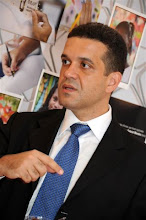Archive for September 2006
Treetap
 The Treetap brand and design born as a way of adding value to raw material known as vegetal leather. Manufactured in Amazon Forest communities from the latex, this technology became an environmentally sustainable way of increasing region's labor income. Designed by Beatriz Saldanha and Tatiana Pinho, manufactured by Couro Vegetal da Amazônia.
The Treetap brand and design born as a way of adding value to raw material known as vegetal leather. Manufactured in Amazon Forest communities from the latex, this technology became an environmentally sustainable way of increasing region's labor income. Designed by Beatriz Saldanha and Tatiana Pinho, manufactured by Couro Vegetal da Amazônia.Couro Vegetal da Amazônia S.A.
Rua Visconde de Pirajá 499 sobre loja.
Rio de Janeiro
phone (+5521) 24331697
Site http://www.amazonlife.com/
Vetor Zero
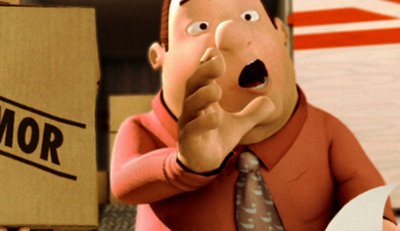 Vetor Zero is a special effects and digital animation company that has been in business for over 18 years, servicing clients in Brazil and world wide with top-level animation work, creative input and technical ingenutity.
Vetor Zero is a special effects and digital animation company that has been in business for over 18 years, servicing clients in Brazil and world wide with top-level animation work, creative input and technical ingenutity.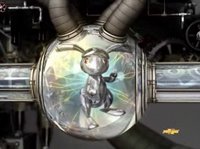 At the forefront of animation and digital effects, Vetor Zero help their clients realize their visions, strengthen thier brands and stand out visually. As a result, their works have been highly regarded and widely rewarded both locally and overseas in all the major advertisement and animation festivals worldwide.
At the forefront of animation and digital effects, Vetor Zero help their clients realize their visions, strengthen thier brands and stand out visually. As a result, their works have been highly regarded and widely rewarded both locally and overseas in all the major advertisement and animation festivals worldwide.From TV packages for Brazilian Networks, to the far out concepts and graphics for Chevrolet, Vector Zero's clients so far include Adams, Audi, Brahma, Coca-Cola, Colgate, Fiat, Ford, Mastercard, Michelin, Nestea, Nissan, ONU, Pepsi, Petrobras, Peugeot, Ruffles, Siemens, Sundown, Telmex, TIM, Toyota, Trakinas, Trident, Unilever, Volkswagen and Wall Mart.
10 Cannes Lions (3 Gold)
1993 - "Worms" - Bronze
1995 - "Spoons" (Kibon) - Silver
1996 - "Ants" (Philco) - Gold
1996 - "Ants with Helmet" (Philco) - Bronze
1998 - "Leds" (Gradiente) - Gold
1998 - "Tree" (Jovem Pan) - Bronze
2000 - "Baby" (Zip Net) - Bronze
2003 - "Flea" (Purina Tratto) - Bronze
2004 - "Together" (Zoo Buenos Aires) - Bronze
New York Festivals
1997 - "Mosquito" (Antena 1) - Gold
1997 - "Leds" (Gradiente) - Gold
2000 - "Baby" (Zip Net) - Gold
2004 - "Fish" (TV Animation Computer) - Bronze
Annecy - Festival International du Film D'Animation (France)
2002 - "Turtle" - Advertising Film Award
Vetor Zero
Phone: +55 (11) 3709.2222
Site: http://www.vetorzero.com/
TIM Home
2. Disk *333 from inside your home.
3. Now you can make every call from your mobile at your homezone to any fixed phone with local fixed shares.
Homezone GSM localization is the use of Multilateration or 'trilateration' to determine the location of GSM mobile phones, usually with the intent to locate the user. You call the *333 and the 'Trilateration' thing begins.
 Trilateration is a method of determining the relative positions of objects using the geometry of triangles in a similar fashion as triangulation. Unlike triangulation, which uses angle measurements (together with at least one known distance) to calculate the subject's location, trilateration uses the known locations of two or more reference points, and the measured distance between the subject and each reference point. To accurately and uniquely determine the relative location of a point on a 2D plane using trilateration alone, generally at least 3 reference points are needed.
Trilateration is a method of determining the relative positions of objects using the geometry of triangles in a similar fashion as triangulation. Unlike triangulation, which uses angle measurements (together with at least one known distance) to calculate the subject's location, trilateration uses the known locations of two or more reference points, and the measured distance between the subject and each reference point. To accurately and uniquely determine the relative location of a point on a 2D plane using trilateration alone, generally at least 3 reference points are needed. Standing at B, you want to know your location relative to the reference points P1, P2, and P3. Measuring r1 narrows your position down to a circle. Next, measuring r2 narrows it down to two points, A and B. A third measurement, r3, gives your coordinates at B. A fourth measurement could also be made to reduce error. And that's why Bin Laden could not have a mobile phone!
Standing at B, you want to know your location relative to the reference points P1, P2, and P3. Measuring r1 narrows your position down to a circle. Next, measuring r2 narrows it down to two points, A and B. A third measurement, r3, gives your coordinates at B. A fourth measurement could also be made to reduce error. And that's why Bin Laden could not have a mobile phone!The beautiful thing about innovation is that it puts all these physics, mathematics and difficult things toghether in my hands to simply order a pizza!
1TIM (TIM Participacoes - Public, NYSE:TSU) is a wireless provider in Brazil. The Company offers value-added services, including short message services or text messaging, multimedia messaging services (MMS), push-mail, Blackberry service, video call, turbo mail, wireless application protocol (WAP) downloads, Web browsing, business data solutions, songs, games, television access, voice mail, conference calling, chats, and other content and services. On March 16, 2006, the Company acquired all of the share capital of TIM Celular S.A.
Siemens Global Network of Innovation

Networks are the talk of the town. Scientists, economists, politicians and philosophers all speak about networks. When people speak about networks, they are always actually speaking about the special relations that make something what it is.
Thus the effectiveness of a medication is based on its molecular components and the special configuration in which these relate to each other. Decisive are not just the "ingredients" but to a large extent the special position of the building blocks in relation to each other.
Siemens is about to win the Finep1 Technological Innovation Prize in Brazil regarding to its Global Network of Innovation.
This can be translated as the company's innovative strength, its innumerous business activities and, of course, its global network, composed of more than 400,000 employees in 190 countries.
Networks describe both complex structures and the special position of the individual elements as a system of relations. Elements such as nodes and links, representing in such case companies and business relationships, can be build and turned on or turned of to accomplish unparalled actions such as new products, process and services.
Siemens acts, like the catalyst - as we speak about chemical complex structures, of this complex structure. In chemistry, a catalyst (Greek: καταλύτης, catalytēs) is a substance that accelerates a reaction, without itself being consumed or changed. In this case the catalyst, or Siemens, change and change a lot, learning with the business environment and participating in the process of innovation, research and entrepreneurship of people, universities, research institutes and companies around it.
Our social world is an intricate universe of social, economic and political relations. Our world is complex. To be sure, this is not a new phenomenon. But it is a fact that the complexity of the world around us is becoming increasingly difficult for the individual to grasp. Companies, like Siemens, are drowning in the short-sighted probabilities of their own decision-making structure. It is becoming increasingly difficult to find a basis for sensible reforms, and new groups of clients are increasingly difficult to reach in a fragmented market. Today's formula is to became one of the nodes or became the catalyst.
 Siemens is strongly represented in Brazil. The Company's first activities in the country date back to 1867, with the installation of the first telegraph line between the states of Rio de Janeiro and Rio Grande do Sul. In 1895, in Rio de Janeiro, it opened its first office and ten years later the Company was founded in Brazil. Siemens is among the leading companies in Brazil's electric and electronic sector, with business activities in the areas of Information and Communications, Automation and Control, Medical, Power, Transportation and Lighting. In Brazil, the Company possesses 10,305 employees, seven research and development centers and sixteen manufacturing facilities, some of which occupy a prominent position within our worldwide organization. Such is the case with the Curitiba plant, a global export center of the HiPath 1000 and 4000 corporate communication platform, marketed worldwide by Siemens.
Siemens is strongly represented in Brazil. The Company's first activities in the country date back to 1867, with the installation of the first telegraph line between the states of Rio de Janeiro and Rio Grande do Sul. In 1895, in Rio de Janeiro, it opened its first office and ten years later the Company was founded in Brazil. Siemens is among the leading companies in Brazil's electric and electronic sector, with business activities in the areas of Information and Communications, Automation and Control, Medical, Power, Transportation and Lighting. In Brazil, the Company possesses 10,305 employees, seven research and development centers and sixteen manufacturing facilities, some of which occupy a prominent position within our worldwide organization. Such is the case with the Curitiba plant, a global export center of the HiPath 1000 and 4000 corporate communication platform, marketed worldwide by Siemens.Don't you think that the Global Network of Innovation deserves this prize?
1 Finep - National Agency for Financing Studies and Researches, is a part of the Ministry of Science and Technology (MCT) created in 1986 specifically for directly promoting and funding R&D&I in Universities and now directly to Private and Public Companies with Federal Government sources.
Coca-Cola Brazil Clean Water

Water. I do not know why, but on the last few weeks I am thinking about the waterways and rivers of my country. It might be the effects of the "What The Bleep do we Know?" movie and from the Masaru Emoto's "Life of Water"1 experiences. Just like a lot of enterprises, and everyones depends of water, Coca-Cola Brazil is helping to improve its quality trought technological innovation and better environmental pratices.

Coca-Cola Brazil2 is one of the beverage company's largest operations in Latin America, providing drinks for thirsty Brazilians through a network of 39 bottling plants that are operated by 18 independent groups working under a franchise system that employs about 25,000 people. Under this business model, the franchisees agree to produce all Coca-Cola products from a supply of concentrates and then bottle and distribute them.
The Cempre (Enterprise Commitment for Recycling), created in 1992 by Coca-Cola and a group of companies, acts in technological research, projects orientation and information diffusion on management of solid residues and recycling, in partnership with reputation entities, as the Institute of Technological Research of São Paulo (IPT).

Besides all soft-drinks brands Coca-Cola Brazil produces bottled mineral water too, the Bonaqua brand, making it from better filtering and environmental managing Systems. A friend of mine that works in the brazilian company swear that a lot of patogenic and natural diseases are interrupted by the filters, chemicals and an intricated industrial process developed by Coca-Cola with a large network of Small and Medium-sized Enterprises (SME) and University research after a long way of 64 years (1942) of technical achievements in our country.
Coca-Cola Brazil uses billions of liters of water per year to manufacture its products. And from the point of view that water is a common good, Coca-Cola Brazil created the Clean Water Program. To have an idea of the dimension of this program, it is enough to say that each year 1 billion of liters of water is saved, the sufficient to supply, annually, a city with 25 thousand inhabitants. This says that the consumption average is of 2,4 liters of water for 1 liter of drink, one of the minors of the world. And we are becoming each year more efficient, thanks to the awareness and to the modern methods of management of the use of water. But the rationalization is not the only objective. The Clean Water Program also treats 14 billion liters of water used in its production process, that in turn are returned to the rivers and lakes to preserve and to improve the quality of the same ones. Coca-Cola Brazil only gives an example of that it is possible to make, so that other company-citizens make the same. The future is thankful.
1 In The Secret Life of Water, bestselling author Masaru Emoto guides us along water’s remarkable journey through our planet and continues his work to reveal water’s secret life to humankind. He shows how we can apply its wisdom to our own lives, and how, by learning to respect and appreciate water, we can better confront the challenges that face the twenty-first century—and rejuvenate the planet.
2 Yes, indeed The Coca-Cola Company has assumed a national position in our contry and begun to use 'Brazil' on it's name and made a little change on it's logo (the yellow & green flag) becoming the first affiliate of the multinational company to have a customized look from the universal brand.
Deflor Bioengineering
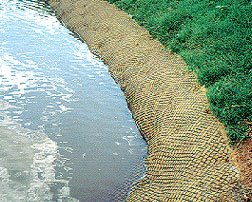 DEFLOR was founded in 1984 to work in environmental protection and pest control. Its activities developed into hydraulic dam cleaning and the recovery of degraded areas. At present DEFLOR manufactures plant and coconut fiber anti-erosion biodegradable blankets and sediment retainers which are sold domestically and internationally. All products abide by the ASTM - American Society for Testing and Materials - international standards. The 15,000 m² manufacturing plant is located in Contagem, MG.
DEFLOR was founded in 1984 to work in environmental protection and pest control. Its activities developed into hydraulic dam cleaning and the recovery of degraded areas. At present DEFLOR manufactures plant and coconut fiber anti-erosion biodegradable blankets and sediment retainers which are sold domestically and internationally. All products abide by the ASTM - American Society for Testing and Materials - international standards. The 15,000 m² manufacturing plant is located in Contagem, MG.DEFLOR has a highly qualified technical staff, including experts to design specific projects for each customer like the Anti-erosion Biodegradable blankets, Sediment Retainers, Erosion and Sediment Control and Environmental Solutions for Degraded Areas and Poluted Waterways.
 The Bermalonga® type sediment retainers may be used to retain, conduct and confine oil and suspended material leakage into a desired site. Those special sediment retainers are widely applied in engineering works. They are light, easily managed, transported, installed and stored. Produced with DEFLOR technology, it is extremely strong and has been successfully used to fill erosion pits, deep erosion gullies, on slope and erosion gully surfacing.
The Bermalonga® type sediment retainers may be used to retain, conduct and confine oil and suspended material leakage into a desired site. Those special sediment retainers are widely applied in engineering works. They are light, easily managed, transported, installed and stored. Produced with DEFLOR technology, it is extremely strong and has been successfully used to fill erosion pits, deep erosion gullies, on slope and erosion gully surfacing.Waterway, canal and hydraulic resevoir recovery and protection is essential to avoid margin undermining, erosion and silting, all of which affect the environment, the community and enterprises. Choosing the most efficient and safest measure among existing products and technology depends on expert knowledge like the one developed by the DEFLOR staff.
DEFLOR
Belo Horizonte - Minas Gerais - Brazil
E-mail :deflor@deflor.com.br
Phone 55 31 3284-5622
Fax 55 31 3284-5688
Dye-cells

The sunlight that reaches the earth’s surface represents a constantly renewable source of energy. Countries whose territories include extensive areas of land near the equator can develop and exploit the abundant sunlight that bathes their land as an alternative source of renewable energy. As solar technology advances, such efforts carry significant environmental and economic benefits.
Brazil is the fifth-largest country in the world in terms of territory, covering more than 8,500,000 square kilometers. Almost 80 percent of this land lies in the tropics between the equator and the Tropic of Capricorn.

Using natural pigements extracted of fruits as blackberry, jabuticaba and caulker (common in the region of Patagonia, in the South America), scientists of the Chemistry Institute (IQ) of the University f Sao Paulo had developed a new technology for the production of cells capable to convert the solar light into electric energy, the Dye-cells® calls - solar cells of thin layer.
Compared with the conventional systems, that they use as substance cousin the silicon, the process presents advantages as the cost of production - esteem in about 30% 50% minor - and the use of materials that do not attack the environment.
In the laboratories of the IQ already exists a 10x10 cm Dye-cell®, with the appearance of a transparent glass, that demonstrate the efficiency of the technology. Andres Sarto Polo, currently on doctoral at the Institute, explains that the system uses as semiconductor the titanium dioxide (TiO2). "This substance is used in the industry in dental creams, inks etc. For being white, it does not absorb the visible light and it needs a pigement to absorb the solar light, that can be extracted from fruits."
In tests made with caulker and jabuticaba, the researchers had obtained to reach powers around 1,5 to 2 miliwatts for squared centimeter (cm2). The control experiments come being carried through in small solar cells that presents an active area of 1/2 cm2. According to Polo, already if it knows that the system with natural pigements is capable to convert the energy proceeding from sun into electricity with efficiency around 1% to 2%.
The next steps to the studies, in accordance with Polo, will be to verify the time of useful life of the cells and the use of different composite.
USP Chemistry Institute
São Paulo - SP
Telephone: (+5511) 3815.3257 / 3091.3839
Website: http://www2.iq.usp.br
Moscamed Biofactory

Fruit farmers of Brazil and of the world have been granted assistance in fighting the worst pests that affect their crops: fruit flies, scientific name Ceratitis Capitata. The Biofabrica Moscamed Brasil factory, in the city of Juazeiro, in the northeastern Brazilian state of Bahia is becoming the first to produce sterile fruit flies to help combat the plague.
Sterile insect technique is a method of biological control, whereby millions of sterile insects are released. The released insects are normally male as it is the female that causes the damage, usually by laying eggs in the crop. The sterile males compete with the wild males for female insects. If a female mates with a sterile male then it will have no offspring, thus the next generation's population is reduced. Repeated release of insects can eventually wipe out a population, though it is often more useful to consider controlling the population rather than eradicating it.
The biofactory, whose target is to produce 200 million sterile male flies per week, is born with the perspective of being an exporter. According to agronomist Antonio Nascimento, the Moscamed Brasil technical and scientific consultant, Spain and South Africa are potential markets for future exports of natural pest control.

The researcher explains that research took ten years. Work by the Brazilian Agricultural Research Corporation (Embrapa), universities and research institutes was necessary to reach the biofactory. "This is truly interdisciplinary and inter-institutional team work," he said. The technology for production of sterile fruit flies is already used in other countries, but not in Brazil, the third largest world producer of fruit. The biofactory is the first of its kind.
According to him, the sterile insect technique will reduce the use of pesticides in Brazilian fruit farming and will represent a positive impact to the environment. "On the other hand, this technology will contribute to the production of more healthy fruit, as well as increasing the Brazilian competitiveness on the foreign fruit market, marked by greater and greater demands with regard to food safety," pointed out Nascimento.
Biofábrica Moscamed
Quadra D13, Lote 15 - Distrito Industrial do São Francisco
Juazeiro - Bahia
Telephone: (+5574) 36125399
Site: www.moscamed.org.br
DryWash

Water (in its pure form) is a tasteless, odorless substance that is essential to all known forms of life. Our planet Earth could be called Water because 2/3 of it is covered by this precious substance that even make 75% of your body. Civilization has historically flourished around rivers and major waterways. Due to overpopulation in several regions of the world, the safe water supply is inadequate as of the year 2006 (and decades prior). Much of the world’s water systems are also aging and in need of major infrastructure improvements.
Current forecasts are that two thirds of the planet will have insufficient water by 2025, when it will be the natural resource more disputed at the majority of countries. In Brazil water in abundance exists, but it also exists the wastefulness and the compromizing of the sources.
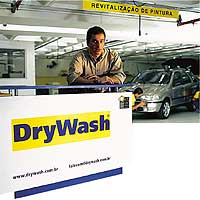 With a hose not very opened, 216 liters of water are spent in 30 minutes of laudering. The DryWash founder, Lito Rodriguez, set out to reverse this trend when he created the company in 1994. Armed with a solid management team and a unique product, he prepared to change the status quo and run a small business that has a compromissing with the future.
With a hose not very opened, 216 liters of water are spent in 30 minutes of laudering. The DryWash founder, Lito Rodriguez, set out to reverse this trend when he created the company in 1994. Armed with a solid management team and a unique product, he prepared to change the status quo and run a small business that has a compromissing with the future.
The main advantage DryWash holds over its rivals is an innovative line of vehicle cleaning solutions that have yet to be replicated with the same degree of quality and efficacy. As its name implies, the company has created products that wash every part of a car without the use of water. Aside from the clear environmental benefits, such as the estimated 450,000,000 liters of water DryWash saved in its first ten years, the superiority of the products themselves is still unmatched.
The original cleaner is a small pad that uses organic Carnauba wax local to Brazil which efficiently removes dirt from the vehicle’s surface with no harmful chemicals. This technology is so successful that it has created significant international interest, allowing DryWash to expand its services into Mexico, Portugal and Australia in addition to the fifty franchises and several mall units it already maintains.
Within Brazil, the company is creating a pro-business environment in an industry dominated by informality and illegal practices. The management team’s focus on operating the most efficient and professional business possible has paid off. New laws have greatly increased the penalty of buying and reselling products illegally, so foreign corporations prefer working with DryWash because of their prospects for future stability and growth. In addition, customers are drawn to the quality of the service and product, generating consistent press coverage and causing sales to increase exponentially. DryWash beat its own sales expectations of $2.4 million by generating $2.7 million in revenue in 2005. The company is continually adjusting its prospects upward, now to $5.46 million in sales for 2008. The DryWash system proved to be so popular, the office began getting calls from clients asking if the products could be used on planes and helicopters, prompting the founders to create a separate branch called DryWash Air.
The company has further improved its efficiency by creating management software that standardizes operations among franchises and car wash units. DryWash is now performing market research to expand its operations into the US with “Eleva,” a new, comprehensive line of sustainable cleaning products.
DryWash
Sao Paulo, SP
e-mail: international@drywash.com.br
website: http://www.drywash.com.br





